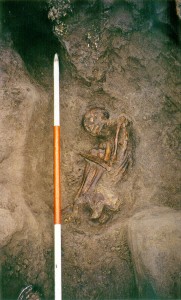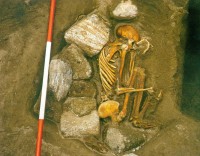 In 2001, archaeologists found two bog mummies, one apparently male, one apparently female, buried under a roundhouse in the prehistoric village of Cladh Hallan on the island of South Uist in Scotland’s Outer Hebrides. There was no soft tissue left, but their skeletons were found in a tight crouch posture, something that would have been impossible to maintain for thousands of years in the soggy environment of the Outer Hebrides without there having been soft tissues keeping the bones in place in the beginning. They made news at the time for being the most ancient mummies discovered in Britain — they’re about 3500 years old — and for having been deliberately mummified.
In 2001, archaeologists found two bog mummies, one apparently male, one apparently female, buried under a roundhouse in the prehistoric village of Cladh Hallan on the island of South Uist in Scotland’s Outer Hebrides. There was no soft tissue left, but their skeletons were found in a tight crouch posture, something that would have been impossible to maintain for thousands of years in the soggy environment of the Outer Hebrides without there having been soft tissues keeping the bones in place in the beginning. They made news at the time for being the most ancient mummies discovered in Britain — they’re about 3500 years old — and for having been deliberately mummified.
Tests indicated that shortly after their deaths, the bodies were placed in a peat bog for about a year until the acidic anaerobic environment good and pickled them. They were removed when the tissue was mummified but before the acidic environment ate away at the bones. Then they were wrapped in fetal position and kept somewhere unknown. Hundreds of years later (about 500 for the male, 300-400 for the female), they were buried under the roundhouse foundations.
Researchers also noticed that the male skeleton was not just one man. The head and neck belonged to one man, the jaw to a second and the body to a third. Radiocarbon dating indicated that the head, neck and jaw were 100 to 200 years younger than the body. At some point during the interregnum between his mummification in the bog and his burial under the roundhouse, parts of him were replaced.
 Isotopic dating and DNA tests carried out last year by University of Manchester biomedical archaeologist Terry Brown have revealed that the Frankensteining of these bog bodies goes far deeper than first realized. He sampled DNA from the jawbone, skull, arm and leg of the female mummy and found that they all came from different people. None of them have mitochondrial DNA in common, so if they were even related, none of them had the same mother.
Isotopic dating and DNA tests carried out last year by University of Manchester biomedical archaeologist Terry Brown have revealed that the Frankensteining of these bog bodies goes far deeper than first realized. He sampled DNA from the jawbone, skull, arm and leg of the female mummy and found that they all came from different people. None of them have mitochondrial DNA in common, so if they were even related, none of them had the same mother.
All of the female’s body parts date to the same period. Isotopic dating on the male skeleton confirmed the earlier result that he was made out of people who died a century or two apart.
Prof Parker Pearson, an expert in the Bronze Age and burial rituals has a theory about why the mummies were put together this way.
“These could be kinship components, they are putting lineages together, the mixing up of different people’s body parts seems to be a deliberate act,” he said.
“I don’t believe these ‘mummies’ were buried immediately, but played an active part in society, as they do in some tribal societies in other parts of the world.”
He said as part of ancestral worship, the mummies probably would have been asked for spiritual advice to help the community make decisions.
This raises the question if there are other composite skeletons that have already been discovered but that we’ve assumed were the remains of only one person. When scientists test bones for DNA, they want to minimize damage to the remains, so they only test from one area. They only tested multiple areas in this case because they had reason to suspect from the fit that some of the bones came from different bodies.
There’s also the question of whether other Bronze Age crouch burials found elsewhere in the UK may have been mummified for a spell. Pearson’s team is examining remains from crouch burials in Cambridge for evidence of previous bog embalming, and they have already found some cases where bacterial decay appears to have been stopped in its tracks, just as it was with the Cladh Hallan bodies.
For more about the Cladh Hallan dig, see the University of Sheffield’s website.
It’s one thing to re-post a news item from some other source as is the case with much of the content on the Internet. It is altogether another thing to read a posting that aggregates information from multiple sources as you have done here. Fascinating. Thank you.
*puts on CSI sunglasses* “We’ve got a puzzle here. A jigsaw puzzle. Looks like they got… BOGGED DOWN.” YEEEEAAAAAAAAHH
Arrrgh …cannot resist to post a frankenstein-recomposed comment back to the Internet:
Not only in our village people used to deposit body parts before erecting edificial constructions for hundreds of years (still in BC though). Having then converted to Christianity, people started collecting items like the “original” collar bones of St. Cat., i.e. all 27 of them. Luckily, it later became illegal to store the remains of loved ones at home – omnes igitur requiescant in pacem. Even by today’s standards, however, mourning periods seem to be organized in ‘stages’ on a regular basis.
Going again back in time with http://www.arch.cam.ac.uk/lrp/bronze.html (3. The body re-imagined): “during the transitional period, much attention is given to the ’making whole’ of the body. Cremated bones are treated in a manner that focuses on re-creating likeness to the skeletal or fleshed body; the body becomes reconstituted as a kind of whole. The bones themselves can, for instance, be re-organised and laid-out in the shape of a body.” …Well, without much wood for cremation but apparently plenty of bogs on the Outer Hebrides, people might have changed funerary customs and, thus, started to puzzle.
:hattip:
Perhaps the mummification didn’t take so well and they had the replace the parts that rotted away.
They would have had to have had a supply of bog mummies for spare parts. Or perhaps they picked the most likely candidates to fit and made them mummies on the spot.
This is the kind of mystery that I love with my history! Why did they do that? What was the purpose? Fascinating stuff here.